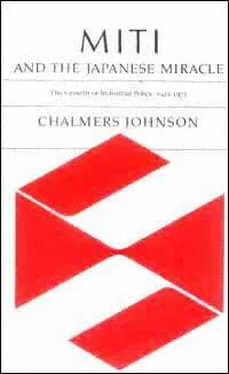Chalmers Johnson - MITI and the Japanese miracle
Здесь есть возможность читать онлайн «Chalmers Johnson - MITI and the Japanese miracle» весь текст электронной книги совершенно бесплатно (целиком полную версию без сокращений). В некоторых случаях можно слушать аудио, скачать через торрент в формате fb2 и присутствует краткое содержание. Год выпуска: 2007, Издательство: Stanford University Press, Жанр: Старинная литература, на английском языке. Описание произведения, (предисловие) а так же отзывы посетителей доступны на портале библиотеки ЛибКат.
- Название:MITI and the Japanese miracle
- Автор:
- Издательство:Stanford University Press
- Жанр:
- Год:2007
- ISBN:нет данных
- Рейтинг книги:3 / 5. Голосов: 1
-
Избранное:Добавить в избранное
- Отзывы:
-
Ваша оценка:
- 60
- 1
- 2
- 3
- 4
- 5
MITI and the Japanese miracle: краткое содержание, описание и аннотация
Предлагаем к чтению аннотацию, описание, краткое содержание или предисловие (зависит от того, что написал сам автор книги «MITI and the Japanese miracle»). Если вы не нашли необходимую информацию о книге — напишите в комментариях, мы постараемся отыскать её.
MITI and the Japanese miracle — читать онлайн бесплатно полную книгу (весь текст) целиком
Ниже представлен текст книги, разбитый по страницам. Система сохранения места последней прочитанной страницы, позволяет с удобством читать онлайн бесплатно книгу «MITI and the Japanese miracle», без необходимости каждый раз заново искать на чём Вы остановились. Поставьте закладку, и сможете в любой момент перейти на страницу, на которой закончили чтение.
Интервал:
Закладка:
During the 1950's the largest proportion of Export-Import Bank loans went for exports, but not all of these truly left the country. A favored category of loans was for what MITI dubbed "plant" (
puranto
) exports, except that the term "plant" in Japanese had come to have a special bureaucratic meaning. Shimamura Takehisa of MITI's Machinery Bureau (MITI 1938 to 1965, and after retirement a senior executive of Furukawa Electric) defined the wordsince there were so few actual exports of complete factories in the early periodto mean any export contract worth more than ¥10 million and with a delay in pay-
Page 209
ment of six months or more. Most "plant exports" in the mid-1950's were actually ships, and a good many of them were only exported for a day. They were then resold back to Japanese shipping companies, the whole transaction having been subsidized by the Export-Import Bank. During the recession of 1954, as we shall see later in this chapter, MITI came up with an even more ambitious scheme for paying for ship "exports"it linked their manufacture and sale to the extremely lucrative sugar and banana importing business.
20
The age was one of quite inventive ad hoc arrangements.
Of the six government banks established between 1949 and 1953 (plus two more that continued undisturbed from the prewar era), the most important for industrial policy was the Japan Development Bank (JDB), created by law number 108 of March 31, 1951.
*
Despite Ikeda's pleas to Dodge that the JDB be allowed to borrow from the postal savings accounts, Dodge refused. During 1951 Dodge authorized disbursements from the savings trusts for specific government projects, but because of SCAP's hostility to the JDB, the funds could not be assigned to cover such an RFB-like operation. SCAP provided all of the JDB's initial capital of ¥10 billion from counterpart funds, and it allowed the bank to be established only on condition that it would not be permitted to issue debentures, borrow funds, or grant loans to cover an enterprise's operating costs. Old occupation hands were still very wary of reigniting inflation. According to SCAP historians, the JDB "was to provide long-term equipment loans to private enterprise when the commercial banks were not in a position to assume the risks involved."
21
Within a year of its creation the JDB became one of MITI's most important instruments of industrial policy. The bank itself had been put under the Ministry of Finance's administrative jurisdiction, but MITI exercised a predominant policy-making influence because it was given the duty of screening all loan applications and making annual estimatesto be transmitted to the bank's board of directorsof the shortfall between available and needed capital. For example, for fiscal 1952 the Enterprises Bureau calculated that investments in the steel industry would require ¥42 billion, of which the steel firms could generate or borrow from their banks ¥31.5 billion, and that coal


*
The eight government banks existing at the end of 1953 were the Central Cooperative Bank for Agriculture and Forestry (1926), the Bank for Commerce and Industrial Cooperatives (1936), the People's Finance Corporation (1949), the Housing Loan Corporation (1950), the Export-Import Bank (1950), the Japan Development Bank (1951), the Agriculture, Forestry, and Fishery Finance Corporation (1953), and the Smaller Business Finance Corporation (1953). See Chalmers Johnson,
Japan's Public Policy Companies
(Washington, D.C.: American Enterprise Institute, 1978).
Page 210
would need ¥40 billion, of which ¥27 billion could be raised from civilian sources. The rest was to be provided by the JDB.
22
In addition to these inputs to the bank, MITI also placed some of its important retired "seniors" on the JDB's board, beginning with Matsuda Taro*, the last MCI vice-minister and a member of the JDB board from August 1952 to June 1957 (Matsuda was succeeded by Yoshioka Chiyozo*, MITI 1934 to 1957, and Yoshioka was succeeded by Imai Hiroshi, MITI 1937 to 1962).
23
Almost as soon as the occupation ended, the government amended the JDB's charter (law number 224 of July 1, 1952) giving it authority to issue its own bonds and lifting the loan ceilings that SCAP had imposed. At the same time the Ministry of Finance modified all of the statutes covering the postal savings accounts, combining them into one large investment pool named the Fiscal Investment and Loan Plan (FILP; Zaisei Toyushi* Keikaku). This "second" or "investment" budget was constructed annually by officials of the Ministry of Finance and of the Industrial Capital Section of MITI's Enterprises Bureau. From 1953 on it became the single most important financial instrument for Japan's economic development.
In order to keep FILP healthy and to ensure that people kept depositing their savings in the post office, the Ministry of Finance made the interest on the first ¥3 million (circa $15,000) that an individual deposited tax exempt and authorized highly competitive interest rates. The system became a rousing success, so much so that during 1980 the total amount of postal savings was estimated at nearly ¥55 trillion (four times the assets of the Bank of America, the world's largest commercial bank); this compares to ¥31 trillion in personal deposits with all city banks and ¥30 trillion in personal deposits with regional banks. (During the 1970's the postal savings system was to become the major means of tax evasion in Japan, since an individual saver could open as many ¥3 million savings accounts as there were post offices in the country, and the Postal Ministry claimed that it was simply unable to monitor the numbers of the accounts involved. To compound the problem, postmasters routinely recommended to savers whose accounts threatened to exceed ¥3 million that they open an account at another post office.)
24
When FILP was created, the Development Bank was authorized to borrow from its funds, and then to make loans to industrial customers who had been approved by MITI.
From 1953 to 1961 the direct supply of capital by the government to industry (as distinct from its indirect supply via overloans) ranged from 38 percent to 19 percent (see Table 15). The JDB itself contributed 22 percent in 1953 and only 5 percent in 1961, but even as the size of
Page 211
its loans declined relative to the expansion of city-bank funding, the bank retained its power to "guide" capital through the indicative effect of its decisions to support or not support a new industry. A JDB loan, regardless of its size, became MITI's seal of approval on an enterprise, and the company that had received a JDB loan could easily raise whatever else it needed from private resources.
25
Much more important than the figures for all industry during the period 195355 are the figures on the JDB's contributions to MITI's designated strategic industrieselectric power, ships, coal, and steel. Some 83 percent of JDB financing in this period went to these four industries, accounting for 23.1 percent of all investment in electric power, 33.6 percent in shipbuilding, 29.8 percent in coal mining, and 10.6 percent in new steel plants.
26
The enormous weight of government investment is the inspiration behind the most common expression employed by Japanese academics to characterize their own economynamely, "state monopoly capitalism" (
kokka dokusen shihon-shugi
)even though the Marxist flavor of this concept is more of a tribute to academic fashion in Japan than it is to any genuine Marxist idea. Professor Endo* explains that he means by the term the activities of the state to supply capital or other funds to industry on terms not available from the private sector and for specific, state-determined policy objectives. In his view FILP is the most typical institution of state monopoly capitalism, a configuration that he believes originated in Japan during the great depression, and that has continued uninterruptedly to the present time.
Читать дальшеИнтервал:
Закладка:
Похожие книги на «MITI and the Japanese miracle»
Представляем Вашему вниманию похожие книги на «MITI and the Japanese miracle» списком для выбора. Мы отобрали схожую по названию и смыслу литературу в надежде предоставить читателям больше вариантов отыскать новые, интересные, ещё непрочитанные произведения.
Обсуждение, отзывы о книге «MITI and the Japanese miracle» и просто собственные мнения читателей. Оставьте ваши комментарии, напишите, что Вы думаете о произведении, его смысле или главных героях. Укажите что конкретно понравилось, а что нет, и почему Вы так считаете.












